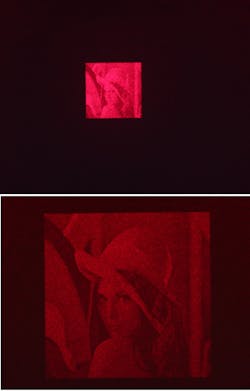As portable digital devices become more prevalent, small image projectors are becoming more important as well; these typically rely on laser or LED light sources, spatial light modulators (SLMs), and imaging lens systems. Most image projectors (large or small) have a zoom function, which requires a zoom lens with movable elements and the mechanics to move individual elements or their combinations, sometimes at different rates.
One way to avoid lenses altogether in projectors is to base them on holography (using an SLM) rather than classical optics; however, a zoom function in holography has previously been difficult to achieve. Now, researchers from Chiba University (Inage-ku, Japan) and Warsaw University of Technology (Warsaw, Poland) have demonstrated a lensless zoomable holographic projector based on so-called scaled Fresnel diffraction.1
ARSS-Fresnel diffraction
The setup for a holographic projector is very simple (see Fig. 1). A singlemode laser beam (in this case, exiting an optical fiber coupled to a laser) is split by a beamsplitter; part of the beam is spatially modulated by a reflective SLM, while the other part remains untouched and serves as the reference beam. The two beams are combined and sent to a projection screen.
The new technique uses the same hardware; the innovation is in the control of the SLM. Using traditional approaches to zoom an SLM-created hologram require massive calculation; the Japanese and Polish researchers earlier proposed a method to reduce the amount of number-crunching via shifted (rather than scaled) Fresnel diffraction, in which diffraction is calculated for different sampling rates on a projected image and hologram and the magnification is adjusted by changing the sampling pitch on the projected image.
But numerical calculations showed that this approach produces aliasing noise on the image. Their new approach, termed “aliasing-reduced scaled and shifted Fresnel diffraction” (ARSS-Fresnel diffraction), corrects this problem by allowing diffraction calculations at different sampling pitches on the SLM and projection-screen planes. Because Fresnel diffraction allows separation of variables, the calculations can be done independently (and more simply) for each dimension; a scaling factor and extra offset are added to the one-dimensional Fresnel-diffraction equation and a substitution containing a variable scaling factor is made to allow the zoom calculations.
To reduce speckle noise, the researchers used a previously developed speckle-reduction method called the “multiple random phase method” in which many different random phase distributions are used to project many (in this case, 20) similar but not identical holograms, masking the speckle by shifting it around at high speed while leaving the image itself virtually unchanged. In addition, another algorithm used by the researchers to optimize their holograms (the Gerchberg-Saxton algorithm) further reduces speckle.
Because the beam from the optical fiber is diverging, the SLM, in addition to producing the hologram’s phase differences, adds in a phase pattern imitating a positive lens with a focal length of 50 mm.
Experimental zoom of 9
As do many imaging and image-processing experiments, the researchers used a standard image of a woman called Lena. First, numerical reconstructions were carried out to confirm that the technique would reduce speckle noise, as well as the rather severe aliasing noise that could appear when the older shifted Fresnel diffraction approach was used. The calculations, which used a wavelength of 671 nm, an SLM pitch of 8 μm, and a projection distance of 200 mm, confirmed the reduction of speckle and absence of aliasing.
Next, an experimental version was set up using a CMOS camera as the image screen, a 2048 × 2048-pixel projected image, and other parameters the same as in the numerical simulation. The researchers were able to zoom the image of Lena by a factor of 9 without aliasing and while maintaining a sharp, speckle-reduced image (see Fig. 2).The group plans to develop a color version of the holographic zoom projector, as well as use a later algorithm to further reduce laser speckle. Currently, the footprint of the holographic zoom system is about 160 × 80 × 40 mm. Tomoyoshi Shimobaba, a professor at Chiba University and one of the researchers, believes the researchers can easily shrink it even further. “Currently, we use commercial parts,” he says. “However, if we customize the components, we believe we can develop the smallest projector [to date] because our technique is in principle the simplest.” He estimates that the technology could be commercialized in the next five to 10 years.
REFERENCE
1. T. Shimobaba et al., Opt. Exp., 21, 21, 25283 (October 21, 2013).
About the Author
John Wallace
Senior Technical Editor (1998-2022)
John Wallace was with Laser Focus World for nearly 25 years, retiring in late June 2022. He obtained a bachelor's degree in mechanical engineering and physics at Rutgers University and a master's in optical engineering at the University of Rochester. Before becoming an editor, John worked as an engineer at RCA, Exxon, Eastman Kodak, and GCA Corporation.


